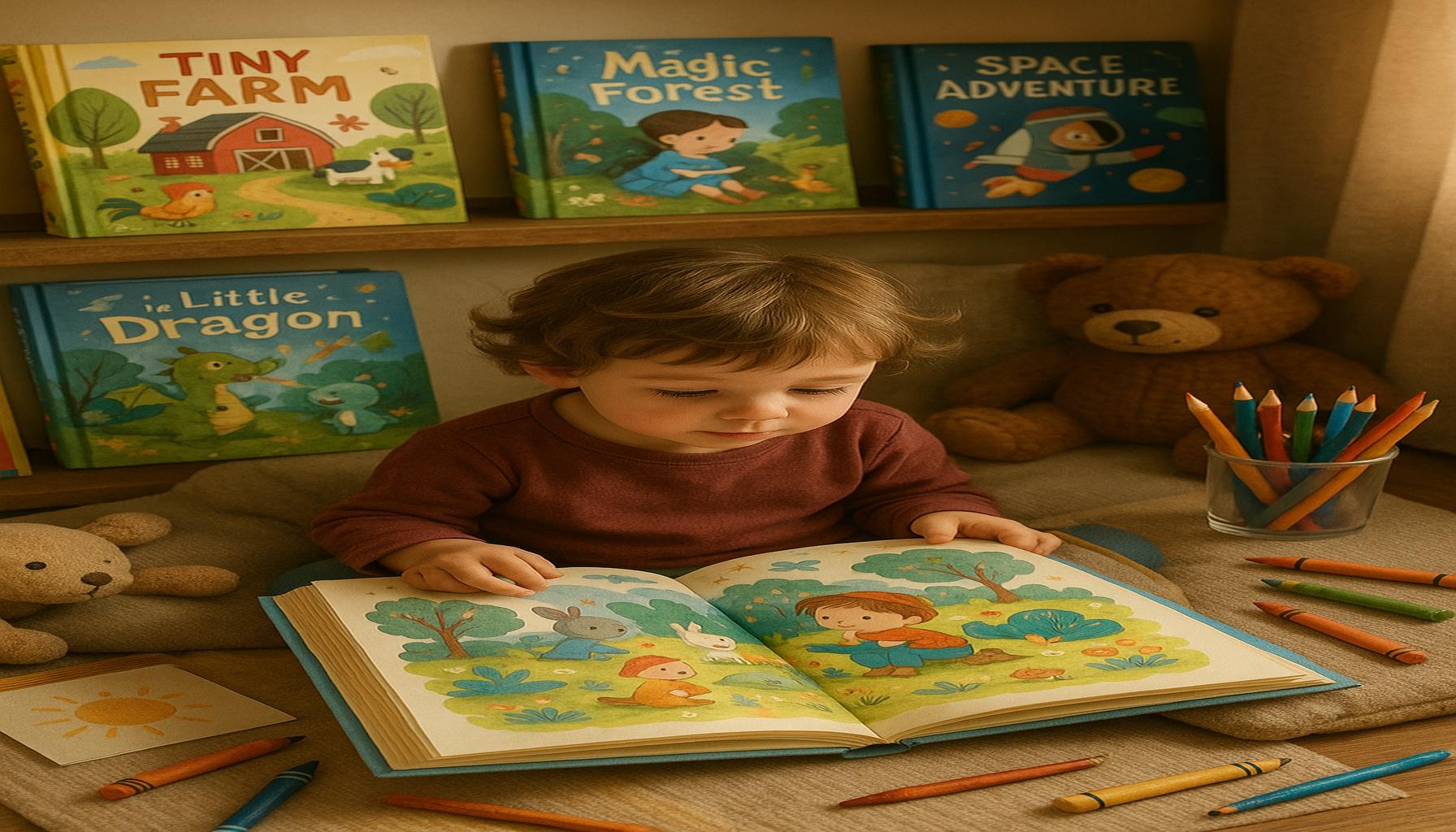The Role of Illustration in Children’s Literature: How Images Enrich Narratives

The Power of Illustrations in Children’s Literature
Illustrations in children’s literature play a pivotal role that extends far beyond mere decoration. These vibrant and dynamic images act as gateways, inviting young readers into the heart of the narrative. For many children, the visual components of a story make it accessible, engaging, and relatable, providing a multifaceted understanding that even the best-written words sometimes cannot convey alone.
One of the key elements to consider is visual learning. Research indicates that a significant portion of children are visual learners, meaning they absorb information better when it’s presented in a pictorial format. For instance, a book about the solar system that includes illustrations of planets, stars, and astronauts enables children to comprehend vast astronomical concepts. Without these visuals, the complexity of space might remain abstract and challenging to grasp. Books such as “There’s No Place Like Space: All About Our Solar System” by Tish Rabe use illustrations to balance educational content with captivating images, fostering a deeper understanding for young readers.
Another critical aspect is cultural reflection. Illustrations provide a canvas for diverse representation, showcasing characters from various backgrounds and cultures. This visual representation is vital in cultivating a sense of belonging and understanding different experiences. For example, the beloved book “Last Stop on Market Street” by Matt de la Peña, illustrated by Christian Robinson, beautifully portrays a multicultural urban environment, allowing children to see themselves and their peers in the stories they read. Inclusion in illustrations helps shape children’s worldviews, creating citizens who appreciate diversity and empathy.
Moreover, emotional engagement is a crucial facet of illustrations. The artwork in a children’s book often elicits a spectrum of feelings, enabling readers to connect with the characters and their journeys on a profound level. For instance, illustrated classics like “The Day the Crayons Quit” by Drew Daywalt use animated drawings to personify crayons, each with their own personality and emotions. This not only captures the imagination of children but also helps them navigate complex emotions of creativity and individuality.
Ultimately, the synergy between text and illustration enriches the reading experience. This partnership allows young readers to unlock their creativity, imagine new worlds, and foster a better understanding of their own environment. As we delve deeper into the world of children’s literature, exploring how illustrations enhance narratives and shape the experiences of myriad children across the United States becomes imperative. Through these stories and images, we not only tell tales but also equip young minds with the tools necessary for emotional intelligence and cultural awareness.

DIVE DEEPER: Click here to discover the power of storytelling
Visual Storytelling: The Impact of Illustrations on Understanding
The importance of illustrations in children’s literature extends into multiple facets of learning and comprehension. As visual storytelling becomes an indispensable aspect of early education, it is essential to delve into how illustrations contribute to children’s understanding of narratives. At its core, illustration serves as a powerful catalyst, enabling children to glean meanings from texts that they may otherwise find challenging without accompanying visuals.
When children open a picture book, they are not just engaging with the words; they are immersed in a multi-sensory experience. In fact, studies have shown that combining visual aids with text can enhance retention and understanding. For young readers, images become bearers of context and emotion, providing clues that words alone may not relay. Consider the use of colors, shapes, and expressions in illustrations: they guide the reader’s emotions, setting the tone for the narrative. For instance, in “Where the Wild Things Are” by Maurice Sendak, the wild creatures are rendered with exquisite detail and emotion, allowing children to feel both the thrill of adventure and the underlying themes of fear and loneliness.
Furthermore, illustrations bridge the gap between the known and the unknown in children’s literature. They empower children to visualize and navigate complex themes, contributing to a comprehensive understanding of the story’s message. Books that tackle difficult subjects, such as grief or bullying, often rely on sensitive illustrations to soften the emotional impact. An exemplar is “The Invisible Boy” by Trudy Ludwig, illustrated by Patrice Barton, which uses soft hues and relatable expressions to depict feelings of isolation and the power of kindness. Through exquisite visuals, complicated emotions become easier to interpret and discuss for both children and parents.
Another remarkable element is the development of narrative skills. Illustrations encourage children to make predictions about a story’s progression. When engaging with a book, young readers often flip through the pages, examining each illustration before reading the text. This anticipatory activity fosters critical thinking and improves comprehension skills. A study by the National Literacy Trust indicates that children who engage with illustrated books demonstrate improved narrative abilities and storytelling skills, as their imaginations become sparked by the visual prompts.
To summarize, illustrations are not incidental; they are a core component in the overarching framework of children’s literature. They provide enriched contexts, emotional depth, and opportunities for skill development that are critical in a child’s formative years. As we explore this intricate relationship between imagery and narrative, it becomes clear that illustrations are fecund enablers of understanding and creativity. The dialogue between text and images continues to nurture an appreciation for reading among children, developing literary skills that will be essential for their future growth and learning.
The Power of Visual Storytelling
Illustration in children’s literature serves as a vital component of storytelling, effectively bridging the gap between the written word and young readers’ comprehension. The interplay of images and text promotes deeper understanding and retention. Visually stimulating illustrations can evoke emotions, making characters and narratives more relatable. This connection through imagery facilitates a child’s ability to grasp complex themes and concepts that might be challenging to understand through text alone.Moreover, illustrations can introduce children to cultural diversity and different life experiences. For instance, books featuring illustrations from various cultures can enrich a child’s worldview, fostering empathy and curiosity about our global community. A vibrant depiction of settings or traditions not only captures attention but also invites conversations that help expand children’s perspectives.
Enhancing Imagination and Creativity
Illustrations often serve as a catalyst for creativity and imagination among young readers. By visualizing scenes described in the text, children are encouraged to explore their own creativity. For instance, an illustration of a fantastical creature or a whimsical landscape inspires children to envision new worlds, encouraging imaginative play. This process not only reinforces the narrative but also leads to enhanced problem-solving skills and cognitive development, as children learn to think critically about the story and the illustrations.In addition, illustrations can act as a springboard for discussions and activities. For example, educators and parents can use the images as prompts for art projects or storytelling exercises, making reading an interactive experience. These activities help nurture a love for literature and an appreciation for the arts.
The Accessibility of Storytelling
Illustrations also play a crucial role in making literature accessible to children of all learning abilities. For young readers who may struggle with decoding text, illustrations serve as an effective means of understanding the story. This accessibility is particularly important in fostering a lifelong love for reading. Books with rich illustrations can attract reluctant readers, drawing them into the narrative and encouraging them to engage with literature in a fun and enjoyable way.Furthermore, interactive illustrations—those that invite reader participation, such as flaps to lift or textures to feel—enhance engagement and make stories more enjoyable. These elements invite children to be part of the narrative, further enriching their reading experience and fostering an early love for books.By examining the depth of illustrations in children’s literature, we can appreciate how they not only embellish tales but also serve transformative functions in the development of young minds.
DISCOVER MORE: Click here to delve deeper
The Power of Cultural Representation in Illustrations
Illustrations in children’s literature do not merely serve the function of enhancing narrative comprehension; they also play a vital role in promoting cultural representation and diversity. In a world increasingly embracing multiculturalism, the inclusion of diverse illustrations is essential for fostering a sense of belonging among young readers from various backgrounds. Seeing characters that reflect their own experiences and ethnicities can significantly impact a child’s self-esteem and understanding of the world around them.
Illustrators are now more adept at weaving cultural elements into their artworks. For instance, in “Last Stop on Market Street” by Matt de la Peña, illustrated by Christian Robinson, the vibrant illustrations capture the essence of urban life while addressing social themes such as poverty and community. The representation of a young African American boy and his grandmother on a city bus allows children to connect with the story’s narrative at a deeper, more relatable level, promoting empathy and awareness of social issues.
Moreover, having diverse illustrations not only supports children in recognizing their own identities but also encourages understanding and appreciation of others’ cultures. Picture books featuring characters from various backgrounds allow children to traverse cultural boundaries, nurturing a global perspective in their early formative years. In this way, illustrations act as gateways to fostering tolerance, encouraging curiosity, and cultivating open-mindedness.
The Role of Illustrations in Language Development
Illustrations are equally pivotal in aiding language development among young readers. Research indicates that the presence of compelling illustrations can ignite a child’s verbal expression, prompting conversations that enhance vocabulary skills. When parents read aloud, they often use illustrations as tools to engage their children, asking questions about what they see and encouraging them to describe emotions depicted in the artwork. This interaction fosters a rich dialogue that supports language acquisition.
For instance, books like “The Very Hungry Caterpillar” by Eric Carle utilize simple yet dynamic illustrations to encourage children to learn basic concepts, such as counting and days of the week. The combination of vivid imagery and engaging narratives enables young readers to grasp linguistic ideas more effectively. By associating words with visual representations, children develop a stronger foundation for language proficiency, benefitting their overall educational journey.
Emotional Intelligence Through Illustrations
Another critical aspect of illustrations in children’s literature is their role in cultivating emotional intelligence. The nuances captured within illustrations can help young readers identify and articulate feelings, leading to improved emotional awareness. By depicting a wide range of emotions through characters’ expressions and body language, illustrators provide children with contexts to explore complex feelings.
In “The Color Monster: A Pop-Up Book of Feelings” by Anna Llenas, colorful illustrations personify different emotions, making them easily recognizable and approachable for young audiences. This kind of visual storytelling allows children to identify their own emotions, fostering discussions that may otherwise be difficult to initiate. By depicting characters in various emotional states, illustrations become instrumental in teaching empathy and understanding, essential tools in navigating social interactions.
As the landscape of children’s literature continues to evolve, the importance of illustrations in enhancing narratives cannot be overstated. From fostering cultural representation to aiding language development and emotional intelligence, illustrations remain at the forefront of enriching the reading experience, creating a multi-dimensional approach to storytelling that is both educational and engaging.
DIVE DEEPER: Click here to unlock the secrets of storytelling
Conclusion
In conclusion, the role of illustrations in children’s literature presents a fascinating interplay between visual artistry and storytelling, creating enriched narratives that resonate deeply with young readers. As we have explored, illustrations serve multiple vital functions—from reinforcing cultural representation and fostering a sense of belonging to aiding in language development and enhancing emotional intelligence. These visual elements help to deepen a child’s understanding of complex themes, encouraging them to engage with stories in a more meaningful way.
The ongoing evolution of children’s literature reflects an increased awareness of the impact that inclusive and diverse illustrations have on young audiences. By portraying a spectrum of characters and cultures, illustrators not only capture the imagination of children but also promote empathy and social awareness from an early age. This cultural literacy paves the way for cultivating compassion and curiosity in our increasingly interconnected world.
Moreover, as parents and educators embrace these illustrated narratives, they open up opportunities for rich discussions that can nurture both linguistic skills and emotional growth. The synergy between text and imagery becomes a powerful tool for sparking conversations about feelings, identities, and the broader human experience. Ultimately, the presence of illustrations transforms children’s literature into a multi-layered exploration of life’s complexities, ensuring that young readers are not just passive consumers of stories, but active participants in a journey of discovery and empowerment.
As we look towards the future of children’s literature, it is essential to continue advocating for the significance of illustrations, ensuring that they remain a cornerstone in enriching narratives that inspire the next generation.



